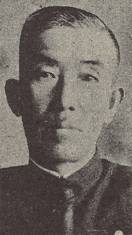| Ide Kaoru | |
|---|---|
 | |
| Born | 1879 (1879) Gifu Prefecture |
| Died | 1944 (aged 64–65) |
| Nationality | Japanese |
| Alma mater | Tokyo Imperial University |
| Occupation | Architect |
| Buildings | Executive Yuan Building, Judicial Yuan Building, Zhongshan Hall |
| Ide Kaoru | |||||||
|---|---|---|---|---|---|---|---|
| Traditional Chinese | 井手薰 | ||||||
| |||||||



Ide Kaoru (井手薰,いで かおる, February 6, 1879 - May 11, 1944) was Chief Architect of the Governor-General's Office in Taiwan, when the island was part of the Japanese Empire. He held office in the Building and Repairs section of the Japanese Government-General in Taiwan, and was mainly involved with government and municipal building projects. His distinctive architectural ideas influenced the Taiwanese architectural profession. He was born in Gifu Prefecture Japan.
Ide Kaoru favoured a "localisation" approach to Taiwan's architecture. He was influenced by Modernism, and in 1929 was elected President of the Taiwan Architectural Association (台湾建築学会, Taiwan Kenchiku Gakkai). He was an advocate of using reinforced concrete, and this featured in almost all his works. Seismic resistance was of the highest priority, as Taiwan is prone to earthquakes.
Amongst Ide's most notable works was the Zhongshan Hall in Taipei, which remains in daily use today as a concert hall and cultural centre. Over the years, many receptions have been held there for heads of state and foreign dignitaries, and in 1992 it was designated a Class Two National Historical Site. He also designed the Judicial Yuan Building in the Imperial Crown style, which was completed in 1934. His design for the Executive Yuan building (completed 1940) was influenced by Art Deco and the work of Frank Lloyd Wright.
Ide graduated from Tokyo Imperial University in 1906, then moved to Taiwan in 1911. He was one of the few Japanese architects to immerse himself professionally in Taiwan, and stayed there for more than thirty years. He also wrote extensively on the subject of architecture.
Notable works
| This section needs additional citations for verification. Please help improve this article by adding citations to reliable sources in this section. Unsourced material may be challenged and removed. (June 2017) (Learn how and when to remove this message) |
- Taipei Presbyterian Church (1916)
- Chienkung Shrine (Kenkō Jinja, 建功神社, 1928) N.B. Heavily modified from its original design after WWII.
- Taipei University School Building and Lecture Hall (1928)
- Taipei Taiwan Education Hall (1931)
- Judicial Office Building (1934)
- Commemorative Exposition of the Beginning of the Governance of Taiwan for 40 years (1935)
- Hsinchu Police Headquarters (1935)
- Taipei Zhongshan Hall (1936, originally Taipei City Public Auditorium)
- Kaohsiung Customs House (1936)
- Taipei Police Headquarters (1936)
- Chiayi Police Headquarters (1937)
- Executive Yuan building (1940)
References
- 光華. 中華民國行政院新聞局. 2005.
- ^ Izumi Kuroishi (23 May 2016). Constructing the Colonized Land: Entwined Perspectives of East Asia Around WWII. Routledge. pp. 141–. ISBN 978-1-317-16144-8.
- "Taipei Zhongshan Hall Management Office | Taipei Travel". Travel.taipei. Archived from the original on 2017-04-02. Retrieved 2017-04-02.
- "National Cultural Heritage Database Management System". Nchdb.boch.gov.tw. 1998-07-30. Retrieved 2017-04-02.
- "Executive Yuan History Exhibit". History.ey.gov.tw. 1998-07-30. Retrieved 2017-04-03.
- "Issue 78/3 – 2010 | ArOr". Aror.orient.cas.cz. 2010-12-22. Retrieved 2017-04-02.
External links
- History Exhibit of Taiwan's Executive Yuan (Parliament) building.
- Judicial Yuan website
- Zhongshan Hall website